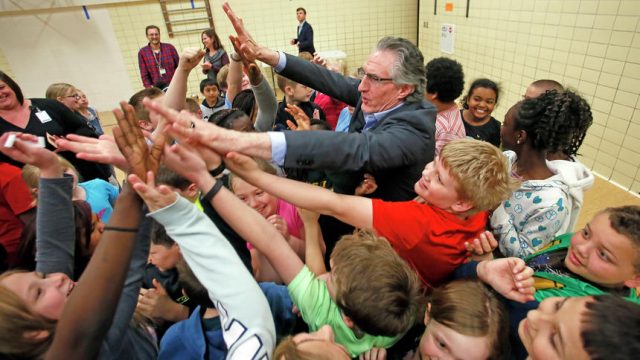Why Can’t the North Dakota University System Be Satisfied With a 31 Percent Increase in Funding for a 7 Percent Increase in Students?

Gov. Doug Burgum dishes out high-fives during his visit with Fargo Lincoln Elementary fourth grade students on Tuesday, April 24, 2018. David Samson / The Forum
At a State Board of Higher Education meeting yesterday there was a lot of griping among some board members about Governor Doug Burgum’s suggested budget cut.
Board Chair Don Morton sounded a different tone in an interview with me earlier this week (audio here). “Every organization has room to find efficiencies,” Morton told me, adding that he likes Burgum’s approach to the budget. “We will live within the budget,” he added.
But his fellow board members seem to be spoiling for a fight with both Burgum and the Legislature, as my colleague Andrew Haffner reports:
Casey Ryan, a member of the State Board of Higher Education, described the prospect of deeper cuts as “incongruent” with the state’s goal of improving the higher education system, particularly the research institutions at the University of North Dakota and North Dakota State University.
“I would tell you there’s no way that’s going to happen if these budget cuts go through,” Ryan said, urging the board to take a more active approach in writing its own funding suggestions. “I can’t go along with us just saying, ‘OK, we just need to see how we can cut things so we can be in line with what the governor is saying.’ ” […]
Ryan, a doctor with Altru Health System in Grand Forks, dismissed the budget suggestions as being in the best interest for the higher ed system, calling himself a “no vote” on any budget that didn’t improve terms for North Dakota’s 11 public schools. He wasn’t alone in resisting Burgum’s guidelines.
It’s worth noting that Ryan was actually appointed to the board by Burgum, and he wasn’t the only member upset over the Governor’s budget proposal. “It’s going to take a lot of personnel out or it’s going to take major programs from our system,” Board member Mike Ness, a Dalrymple appointee whose term ends in June, said. “I don’t think we as a board should just accept that like we did last legislative session.”
This budget posturing is deserving of some context, and that’s easy to do thanks to this graph from Legislative Council juxtaposing general fund appropriations to the North Dakota University System going back to the 2007 – 2009 biennium alongside the trend line for full time equivalent enrollment at the universities.
What we can see is that, even despite a 31 percent decrease in general fund appropriations since the 2013-2015 budget period (the peak of the oil boom years) to the current biennium, there has still been a more than 32 percent increase in spending over the last decade.
Over just a 7 percent increase in full time equivalent enrollment, to boot.
What the board members are griping about is the Legislature not sustaining spending levels that are unsustainable.
Don’t get me wrong, the Republican-controlled legislature and our previous Republican governors pulled that stunt across the budget. They built big budget increases on the back of revenues driven by high commodity prices in the agriculture and energy industries. That was a mistake. They shouldn’t have done it. Our Democratic friends, because it’s a campaign year, are claiming that the problem is income tax cuts and oil tax reforms passed in previous sessions reducing revenues.
But the income tax cuts were modest, and the oil tax reforms have resulted in more than $1 billion in additional revenues since January 2016.
The problem was spending. The problem is spending.
The question for the North Dakota University system is why a 31 percent increase in general fund appropriations over a 7 percent increase in full time equivalent enrollment isn’t enough for them?
The answer probably lays in the fact that we have 11 public institutions of higher education in a state where the population is equivalent to a medium sized city in some other states. It’s hard to imagine how we’re ever going to make higher education in North Dakota efficient as long as that reality exists.





